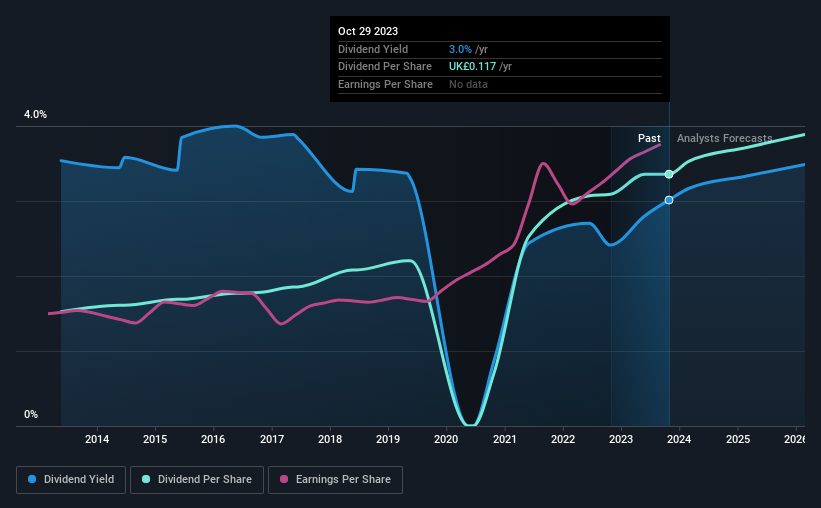Bloomsbury Publishing Plc (LON:BMY) Will Pay A UK£0.037 Dividend In Three Days
Some investors rely on dividends for growing their wealth, and if you're one of those dividend sleuths, you might be intrigued to know that Bloomsbury Publishing Plc (LON:BMY) is about to go ex-dividend in just three days. Typically, the ex-dividend date is one business day before the record date which is the date on which a company determines the shareholders eligible to receive a dividend. The ex-dividend date is an important date to be aware of as any purchase of the stock made on or after this date might mean a late settlement that doesn't show on the record date. Thus, you can purchase Bloomsbury Publishing's shares before the 2nd of November in order to receive the dividend, which the company will pay on the 1st of December.
The company's upcoming dividend is UK£0.037 a share, following on from the last 12 months, when the company distributed a total of UK£0.12 per share to shareholders. Based on the last year's worth of payments, Bloomsbury Publishing has a trailing yield of 3.0% on the current stock price of £3.9. We love seeing companies pay a dividend, but it's also important to be sure that laying the golden eggs isn't going to kill our golden goose! So we need to investigate whether Bloomsbury Publishing can afford its dividend, and if the dividend could grow.
View our latest analysis for Bloomsbury Publishing
If a company pays out more in dividends than it earned, then the dividend might become unsustainable - hardly an ideal situation. Bloomsbury Publishing paid out 53% of its earnings to investors last year, a normal payout level for most businesses. A useful secondary check can be to evaluate whether Bloomsbury Publishing generated enough free cash flow to afford its dividend. It paid out more than half (57%) of its free cash flow in the past year, which is within an average range for most companies.
It's positive to see that Bloomsbury Publishing's dividend is covered by both profits and cash flow, since this is generally a sign that the dividend is sustainable, and a lower payout ratio usually suggests a greater margin of safety before the dividend gets cut.
Click here to see the company's payout ratio, plus analyst estimates of its future dividends.
Have Earnings And Dividends Been Growing?
Stocks in companies that generate sustainable earnings growth often make the best dividend prospects, as it is easier to lift the dividend when earnings are rising. If earnings decline and the company is forced to cut its dividend, investors could watch the value of their investment go up in smoke. For this reason, we're glad to see Bloomsbury Publishing's earnings per share have risen 17% per annum over the last five years. Bloomsbury Publishing is paying out a bit over half its earnings, which suggests the company is striking a balance between reinvesting in growth, and paying dividends. This is a reasonable combination that could hint at some further dividend increases in the future.
Another key way to measure a company's dividend prospects is by measuring its historical rate of dividend growth. Bloomsbury Publishing has delivered an average of 8.2% per year annual increase in its dividend, based on the past 10 years of dividend payments. It's encouraging to see the company lifting dividends while earnings are growing, suggesting at least some corporate interest in rewarding shareholders.
Final Takeaway
Should investors buy Bloomsbury Publishing for the upcoming dividend? It's good to see earnings are growing, since all of the best dividend stocks grow their earnings meaningfully over the long run. That's why we're glad to see Bloomsbury Publishing's earnings per share growing, although as we saw, the company is paying out more than half of its earnings and cashflow - 53% and 57% respectively. In summary, while it has some positive characteristics, we're not inclined to race out and buy Bloomsbury Publishing today.
So while Bloomsbury Publishing looks good from a dividend perspective, it's always worthwhile being up to date with the risks involved in this stock. For example, we've found 2 warning signs for Bloomsbury Publishing that we recommend you consider before investing in the business.
A common investing mistake is buying the first interesting stock you see. Here you can find a full list of high-yield dividend stocks.
Have feedback on this article? Concerned about the content? Get in touch with us directly. Alternatively, email editorial-team (at) simplywallst.com.
This article by Simply Wall St is general in nature. We provide commentary based on historical data and analyst forecasts only using an unbiased methodology and our articles are not intended to be financial advice. It does not constitute a recommendation to buy or sell any stock, and does not take account of your objectives, or your financial situation. We aim to bring you long-term focused analysis driven by fundamental data. Note that our analysis may not factor in the latest price-sensitive company announcements or qualitative material. Simply Wall St has no position in any stocks mentioned.

